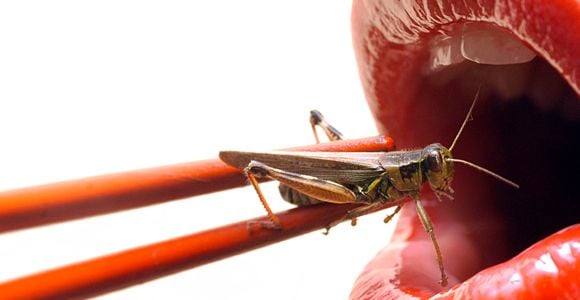What's the weirdest food you've ever eaten? Frog legs? Caviar? Alligator? Although these foods seem strange, they've become quite common. But did you know that people eat tarantulas in Cambodia or grasshoppers in Mexico? Do you think that they eat them because they taste good, or do you think there are any nutritional benefits to these exotic foods?
1. Fried Tarantulas
Fried tarantulas can be found on the streets in Cambodia. They're fried whole in a pan with some garlic and salt, which leaves the outside crispy and the inside soft. There isn't any nutritional information for these healthy snacks, but the Cambodians believe that they can help relieve back aches and help children with breathing problems.
2. Grasshoppers
Grasshoppers are commonly eaten in Mexico. After being washed, they're toasted with garlic, lime juice, and salt. These crispy snacks are actually very high in protein. Per 100 grams of a larger grasshopper, there are about 14 grams of protein. They are also low in fat at 3.3 grams and low in carbs at 2.2 grams. They contain 3 milligrams of iron, which is about 16 percent of the recommended daily value.
3. Bird's Nest Soup
Bird's nest soup is a delicacy in China. The edible birds' nests are created by a few different species of swift, but instead of using twigs, the nests are created with the birds' saliva. The birds' nest turns into a gelatinous texture when it's dissolved in water, which creates a soup. The nests have high levels of calcium, iron, potassium and magnesium. They also have been shown to aid digestion, improve focus, and benefit the immune system.
4. Caterpillars
It's very common to eat either raw or fried caterpillars in Botswana. They're seasoned with onion, tomatoes, and spices. They're also a great source of protein. In 100 grams of caterpillars, there's about 28.2 grams of protein, which is about the same amount of protein that's found in 100 grams of broiled cod. It's also very high in iron at 35.5 milligrams.
5. Balut
Balut is commonly eaten in the Philippines and Southeast Asia. It's a fertilized duck or chicken egg with an almost developed embryo. The egg is then boiled and eaten in the shell. Balut is fairly low in calories with the amount in 1 egg being 188 calories. It's high in fat at 14 grams and high in protein, also at 14grams. It's also very high in cholesterol at 619 milligrams, which isn't surprising as eggs are pretty high in cholesterol to begin with.
6. Casu Marzu
Casu Marzu is originally from Sardinia, Italy. It's a cheese that comes from a special breed of sheep. The cheese is soaked in brine, smoked and left out in the open to allow "cheese flies" to lay eggs in it. There isn't really any nutritional information available however, it's known that the larvae aren't always killed by stomach acid and may live in your intestines for a while. This can cause nausea, vomiting, and bloody diarrhea. You also may need to wear safety goggles when eating it to prevent the maggots from jumping into your eyes.
Although these foods may seem strange and exotic to us, they're fairly common in other countries, and many of them are actually very nutritious. Should you wish to go out and try any of these, you'd be better off trying the caterpillars or grasshoppers. Meanwhile, it's highly advised to avoid the Casu Marzu unless you're willing to risk the side effects all for the joy of the taste.
Kelly Forness is a Dietetic Technician, Registered (DTR) and a member or the American Dietetic Association. She recently obtained her Certificate of Training in Childhood and Adolescent Weight Management. She has experience working in long term care facilities and is currently working at a daycare. Kelly has always been interested in nutrition and fitness her whole life. Kelly is a vegetarian, and tries to eat mostly whole foods. In her free time, she likes spending time with her friends and family, working out, and playing with her 2 cats Chloe and Daisy and dog Charlotte. Kelly can be reached via email at [email protected].



